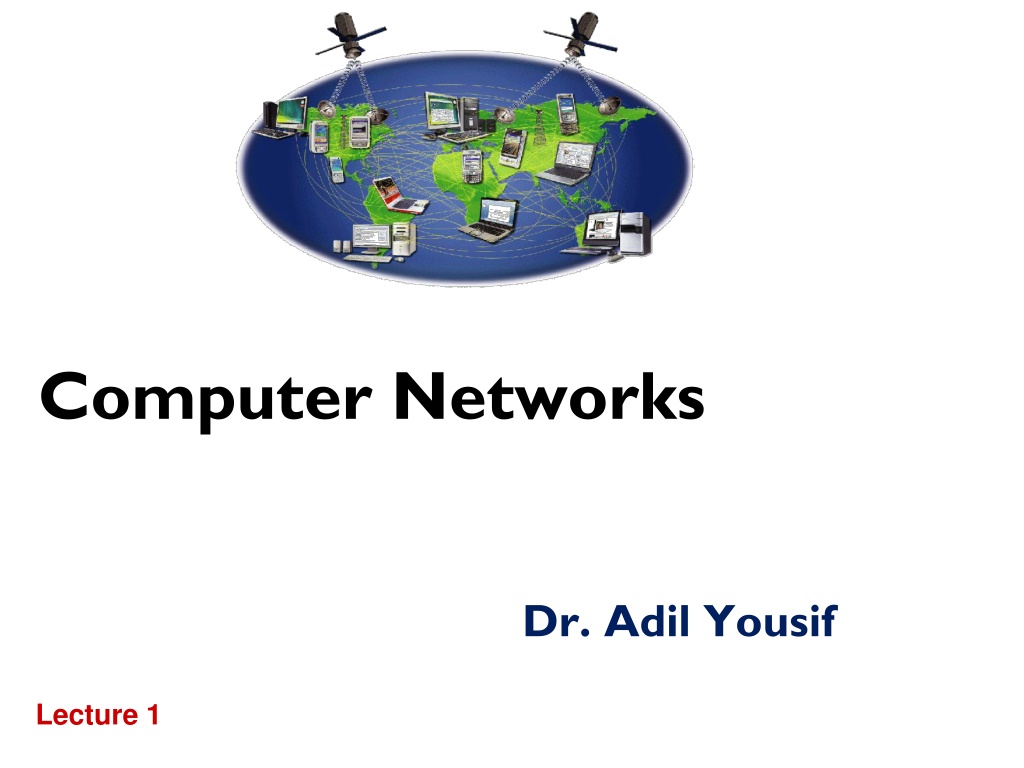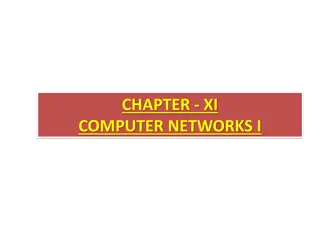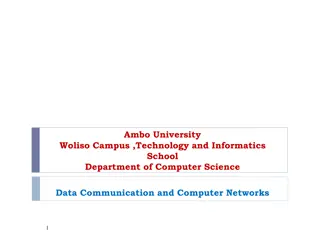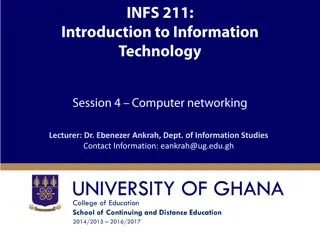Understanding Computer Networks: Dr. Adil Yousif's Lecture Insights
Delve into the fundamentals of computer networks with Dr. Adil Yousif's lecture series. Explore evaluation methods, course outlines, internet mechanisms, protocols, and more. Gain insights into the world of networking through engaging visuals and educational resources.
Download Presentation

Please find below an Image/Link to download the presentation.
The content on the website is provided AS IS for your information and personal use only. It may not be sold, licensed, or shared on other websites without obtaining consent from the author. Download presentation by click this link. If you encounter any issues during the download, it is possible that the publisher has removed the file from their server.
E N D
Presentation Transcript
Computer Networks Dr. Adil Yousif Lecture 1
Evaluation Method 30 % Assignments + Lab. 70% Final Exams
Textbooks Computer Networking: A Top Down Approach Six edition. Jim Kurose, Keith Ross Addison-Wesley, July 2012.
Course Outlines Introduction Application Layer Transport Layer Network Layer Introduction 2-4
Whats the Internet: nuts and bolts view PC mobile network millions of connected computing devices: hosts = end systems running network apps smartphone server global ISP wireless laptop home network communication links fiber, copper, radio, satellite transmission rate: bandwidth regional ISP wireless links wired links Packet switches: forward packets (chunks of data) routers and switches institutional network router 1-5 Introduction
Whats the Internet: nuts and bolts view mobile network Internet: network of networks Interconnected ISPs protocols control sending, receiving of msgs e.g., TCP, IP, HTTP, Skype, 802.11 Internet standards RFC: Request for comments IETF: Internet Engineering Task Force global ISP home network regional ISP institutional network 1-6 Introduction
Whats a protocol? human protocols: what s the time? I have a question introductions network protocols: machines rather than humans all communication activity in Internet governed by protocols specific msgs sent specific actions taken when msgs received, or other events protocols define format, order of msgs sent and received among network entities, and actions taken on msg transmission, receipt 1-7 Introduction
Whats a protocol? a human protocol and a computer network protocol: Hi TCP connection request Hi TCP connection response Got the time? 2:00 Get http://www.awl.com/kurose-ross <file> time Q: other human protocols? 1-8 Introduction
A closer look at network structure: network edge: hosts: clients and servers servers often in data centers mobile network global ISP home network access networks, physical media: wired, wireless communication links regional ISP network core: interconnected routers network of networks institutional network 1-9 Introduction
Internet structure: network of networks End systems connect to Internet via access ISPs (Internet Service Providers) Residential, company and university ISPs Access ISPs in turn must be interconnected. So that any two hosts can send packets to each other Resulting network of networks is very complex Evolution was driven by economics and national policies Let s take a stepwise approach to describe current Internet structure
Internet structure: network of networks Question: given millions of access ISPs, how to connect them together? access net access net access net access net access net access net access net access net access net access net access net access net access net access net access net access net
Internet structure: network of networks Option: connect each access ISP to every other access ISP? access net access net access net access net access net access net access net connecting each access ISP to each other directly doesn t scale: O(N2) connections. access net access net access net access net access net access net access net access net access net
Internet structure: network of networks Option: connect each access ISP to a global transit ISP? Customer and provider ISPs have economic agreement. access net access net access net access net access net access net access net global ISP access net access net access net access net access net access net access net access net access net
Internet structure: network of networks But if one global ISP is viable business, there will be competitors . access net access net access net access net access net access net access net ISP A access net access net ISP B ISP C access net access net access net access net access net access net access net
Internet structure: network of networks But if one global ISP is viable business, there will be competitors . which must be interconnected Internet exchange point access net access net access net access net access net IXP access net access net ISP A IXP access net access net ISP B ISP C access net access net peering link access net access net access net access net access net
Internet structure: network of networks and regional networks may arise to connect access nets to ISPS access net access net access net access net access net IXP access net access net ISP A IXP access net access net ISP B ISP C access net access net regional net access net access net access net access net access net
Internet structure: network of networks and content provider networks (e.g., Google, Microsoft, Akamai ) may run their own network, to bring services, content close to end users access net access net access net access net access net IXP access net access net ISP A Content provider network IXP access net access net ISP B ISP B access net access net regional net access net access net access net access net access net
Internet structure: network of networks Tier 1 ISP Tier 1 ISP Google IXP IXP IXP Regional ISP Regional ISP access ISP access ISP access ISP access ISP access ISP access ISP access ISP access ISP at center: small # of well-connected large networks tier-1 commercial ISPs (e.g., Level 3, Sprint, AT&T, NTT), national & international coverage content provider network (e.g, Google): private network that connects it data centers to Internet, often bypassing tier-1, regional ISPs 1-18 Introduction
Tier-1 ISP: e.g., Sprint POP: point-of-presence to/from backbone peering to/from customers 1-19 Introduction
Protocol layers Networks are complex, with many pieces : hosts routers links of various media applications protocols hardware, software Question: is there any hope of organizing structure of network? . or at least our discussion of networks? 1-20 Introduction
Organization of air travel ticket (complain) ticket (purchase) baggage (claim) baggage (check) gates (unload) gates (load) runway landing runway takeoff airplane routing airplane routing airplane routing a series of steps 1-21 Introduction
Layering of airline functionality ticket (purchase) ticket (complain) ticket baggage baggage (check) baggage (claim gate gates (load) gates (unload) takeoff/landing runway (takeoff) runway (land) airplane routing airplane routing airplane routing airplane routing departure airport airplane routing intermediate air-traffic control centers arrival airport layers: each layer implements a service via its own internal-layer actions relying on services provided by layer below 1-22 Introduction
Why layering? dealing with complex systems: explicit structure allows identification, relationship of complex system s pieces layered reference model for discussion modularization eases maintenance, updating of system change of implementation of layer s service transparent to rest of system e.g., change in gate procedure doesn t affect rest of system layering considered harmful? 1-23 Introduction
Internet protocol stack application: supporting network applications FTP, SMTP, HTTP transport: process-process data transfer TCP, UDP network: routing of datagrams from source to destination IP, routing protocols link: data transfer between neighboring network elements Ethernet, 802.11 (WiFi), PPP physical: bits on the wire application transport network datalink physical 1-24 Introduction
ISO/OSI reference model presentation: allow applications to interpret meaning of data, e.g., encryption, compression, machine-specific conventions session: synchronization, checkpointing, recovery of data exchange Internet stack missing these layers! these services, if needed, must be implemented in application needed? application presentation session transport network datalink physical 1-25 Introduction
Encapsulation source message application transport network link physical M segment datagram frame Ht Ht M Hn Hn Hn Ht Ht M M Hl link physical switch destination network link physical Hn Ht M Hl Hn Ht M application transport network link physical Hn Ht M M Ht M Hn Ht M router Hl Hn Ht M 1-26 Introduction
Questions These slides are adapted from Computer Networking: A Top Down Approach Jim Kurose, Keith Ross Addison-Wesley March 2012























